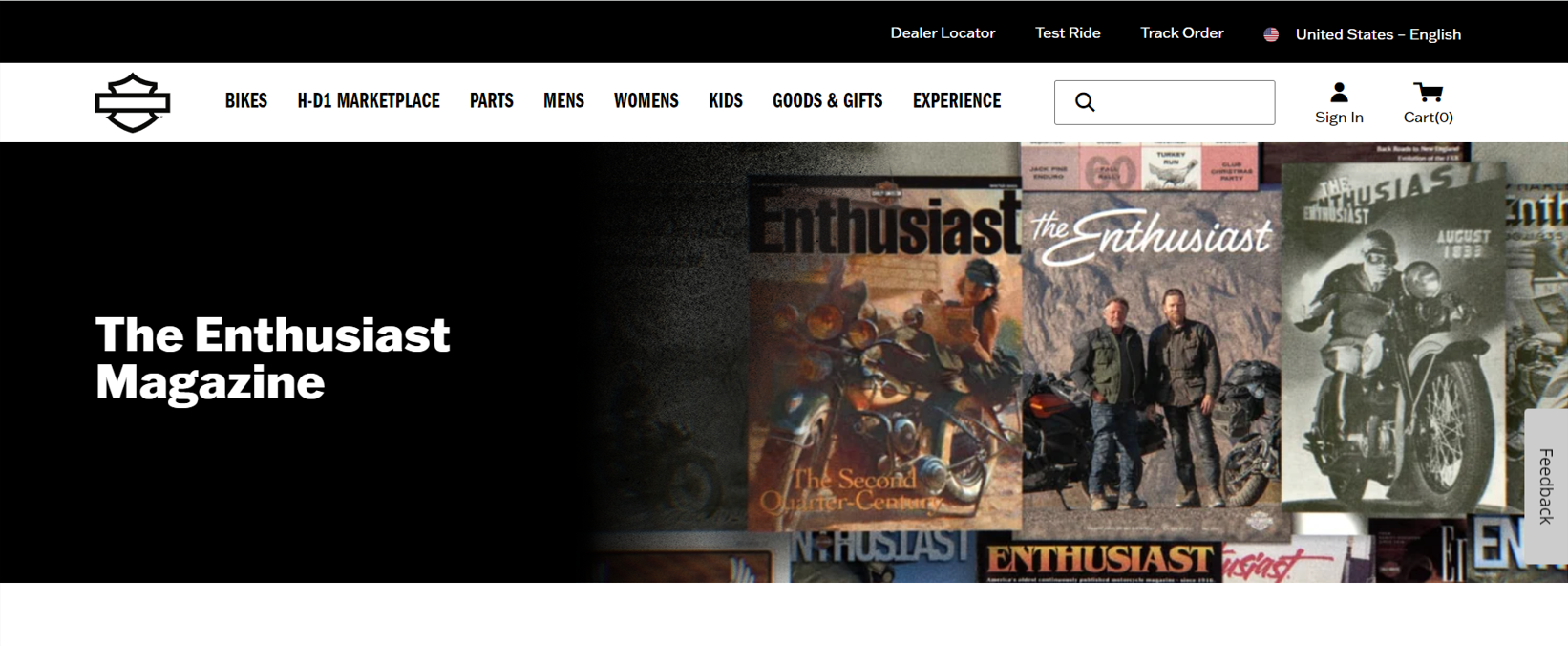- HOME
- Ecommerce marketing
- Blogging for ecommerce: The complete blog strategy guide
Blogging for ecommerce: The complete blog strategy guide
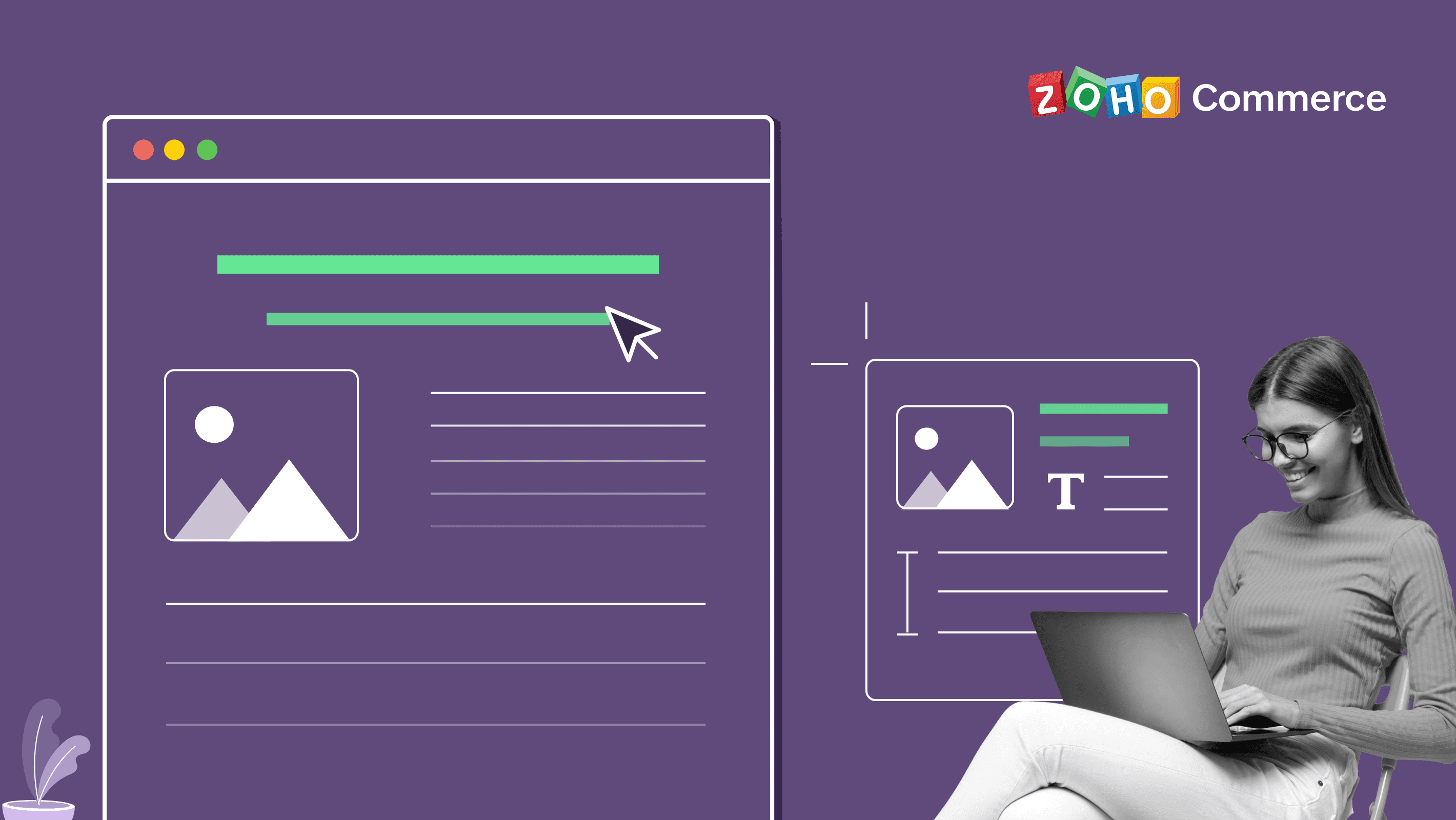
Blogging is a powerful tool for ecommerce businesses, yet it's often overlooked in favor of other digital marketing strategies. However, if done right, blogging can be an effective way to drive more traffic to your ecommerce website and increase sales.
Not only can blogging lead to increased visibility and website visits, but it can also be used as a powerful tool for your business in other unexpected ways. You may be surprised at the diverse benefits of starting a blog for your ecommerce website and the positive impact it can have on your bottom line.
With more customers turning to digital content for information and advice when making purchasing decisions, it's essential for ecommerce businesses to have an established blog presence.
With this in mind, this article will explore the unexpected benefits of starting a blog and how it can help you to generate more online traffic for your business.
What is an ecommerce blog?
An ecommerce blog is a dedicated content platform integrated into your online store where you can share valuable, relevant content to attract, engage, and convert your target audience into customers.

It is a great way to create engaging content that your customers will be interested in reading. You can use it to provide helpful advice, showcase new products or services, share stories about your brand, and much more.
By incorporating blogging into your marketing strategy, you’ll be able to reach a larger audience and build relationships with potential customers who are interested in what you have to offer.
Benefits of blogging for ecommerce
Blogging is an effective way of bringing more attention to your products and services online, as well as providing helpful tips that customers may find useful. It helps you establish yourself as a thought leader in the industry, which in turn can help build trust with potential customers who may not be familiar with your brand yet. According to a study by Marketpath, small businesses that blog get 126% more lead growth than those that don’t.
Putting out useful content around your niche topics is a way of telling your potential customers that you are knowledgeable and trustworthy—both invaluable qualities when it comes to creating lasting relationships.
Attracts more traffic to your site
A well-crafted blog post can reach a wide variety of visitors and has the potential to increase website traffic significantly. By creating interesting, informative content that appeals to readers, businesses have an opportunity to gain loyal followers and grow their customer base. First Site Guide states that, 61% of online users in the US have bought something after reading a blog.

Source: First Site Guide
When done correctly, blogging can also help customers gain confidence in a business. From sharing product updates and reviews to offering helpful advice or tips related to the industry, blogging allows companies to tell their stories while building trust with potential buyers.
Furthermore, by regularly producing new content through articles or blogs that are optimized for search engines such as Google, businesses can improve website visibility and experience an even greater surge in website traffic.
Builds brand awareness and credibility
By sharing your expert knowledge and insights on the blog, you can build trust and credibility with your audience. This can encourage people to do business with you and become loyal customers. Blogging can be an incredibly effective way of getting your name out there and establishing trust with potential customers. Blogging can be an incredibly effective way of getting your name out there and establishing trust with potential customers. In fact, Fit Small Business reports that 80% of businesses use blogs for marketing.
Creating content that resonates with readers can help you stand out from the competition and make people more likely to remember your brand for future purchases.
From personal stories about your journey as a business owner, or detailed product reviews, great blog content will keep visitors coming back for more and encourage them to tell their friends about you too.
Harley Davidson documents some interesting stories in The Enthusiast Magazine. Their content has helped create a cult around their bikes and the lives of bikers who use them. It has created a subculture around Harley Davidson bikes simply by bringing out interesting stories of bikers around the world.
Generates leads and sales
If you include calls to action and links to your ecommerce website on your blog, you can encourage people to buy your products or use your services. Valuable content makes it easy for people to take action, which will boost your sales and conversions.
A study by Lyfe Marketing states that 57% of online marketers claim blogging gave them new customers. Blogs can be used in a variety of ways to build relationships with customers and close more sales.
You can provide valuable tips on using your products or services, highlight customer success stories, share industry news, or introduce new products and services. It’s a great way to engage visitors with relevant content while driving them towards making a purchase decision.
Cultivates customer community and loyalty
Blogs are a great way for ecommerce businesses to connect with their audience and build relationships. They provide the opportunity to engage customers, increase loyalty, and establish a sense of community amongst followers.
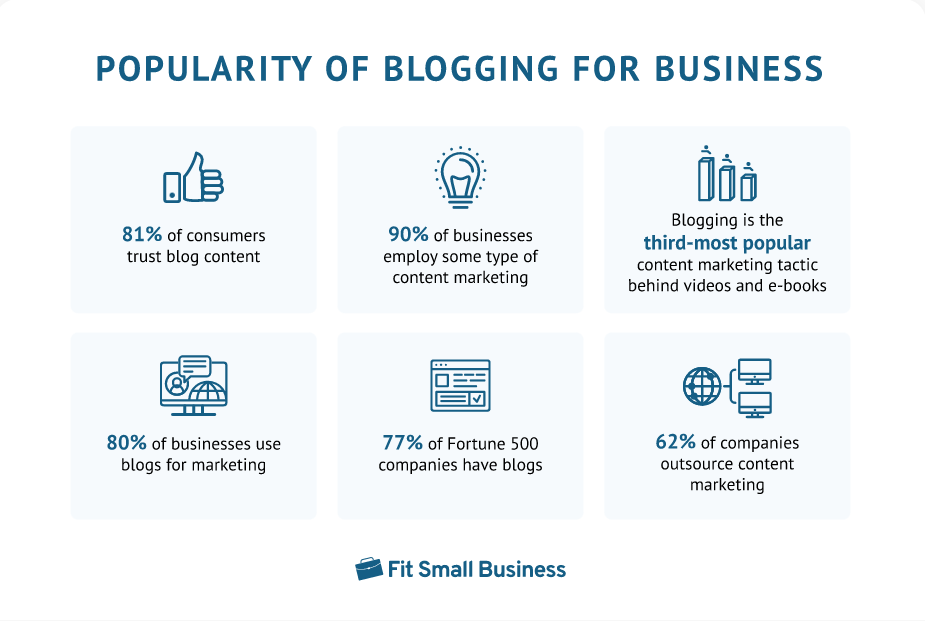
Source: Small Fit Business
By creating content around topics related to your business or industry, you can keep your audience informed on the latest news and trends while offering helpful advice they can use in their everyday lives.
You can also link to relevant products within your blog posts, giving readers easy access if they’re interested in making a purchase. Not only will this create more opportunities for sales, but customers will come back knowing they’ll receive valuable information each time they visit your blog.
Have you checked the website of online marketer Neil Patel? His blogs provide several actionable solutions to visitors with a huge repository of engaging content. Aided by several follow-up emails and pop-up questions, he has been able to create sound business for himself while connecting with his audience.
Strengthens your competitive advantage
Blogs provide an opportunity for ecommerce businesses to differentiate themselves from the competition by creating unique content that resonates with their target audience.
Having a blog can differentiate an ecommerce business from others in several ways. One way is by providing valuable and informative content to customers that can help educate them on products and services offered by the business, as well as provide a deeper understanding of the industry or market in which the business operates. This can help establish the business as an authority and thought leader in its field.
Another way that a blog can differentiate an ecommerce business is by providing a platform for building and engaging with a community of customers and followers. Through regular blog updates, businesses can share news, promotions, and other information, and encourage customer feedback and participation. This can help create a sense of loyalty and engagement among customers, which can drive repeat business and positive word-of-mouth.
Finally, a blog is a great way for ecommerce businesses to showcase their products and services in a different way. Blog post with photos and videos can help customers to see the products and services in action, and learn more about them than just reading about it.
They can be used to showcase product features and benefits, highlight customer stories, or share tips and advice related to your industry. This will give your business a competitive edge on other businesses who don’t have blogs or are not active on them.
Improves SEO for your ecommerce site
Creating content on topics related to your ecommerce business will help boost SEO because it provides fresh content for search engine algorithms, which makes it easier for potential customers to find your website.

When writing posts, don’t forget to include keywords related to your business; this will help potential customers find you more easily when they use those keywords in their searches.
Additionally, blogs are great spaces for sharing links back to other pages on your website or external resources; these links improve both user experience on your website and increase the number of backlinks pointing towards it.
Increases reach
Blogging is an inexpensive and straightforward way to help drive traffic, build relationships with customers and stakeholders, establish industry authority, and ultimately boost sales.
An effective blog should be tailored to the interests of its target audience and reflect their needs and wants. It should address questions they may have regarding your products or services. Additionally it’s important to ensure that the blogs are well-researched, interesting and informative, bringing value to readers.
Regular posting will help keep brand visibility high amongst potential customers besides helping increase search engine rankings which can lead to more organic traffic.
Converts visitors into customers
A blog gives people interesting information about your ecommerce business and encourages them to take action. They are a great way for customers to learn more about upcoming promotions, new product releases, or special offers.
When they have this information in front of them, they’re more likely to take action and purchase from you.
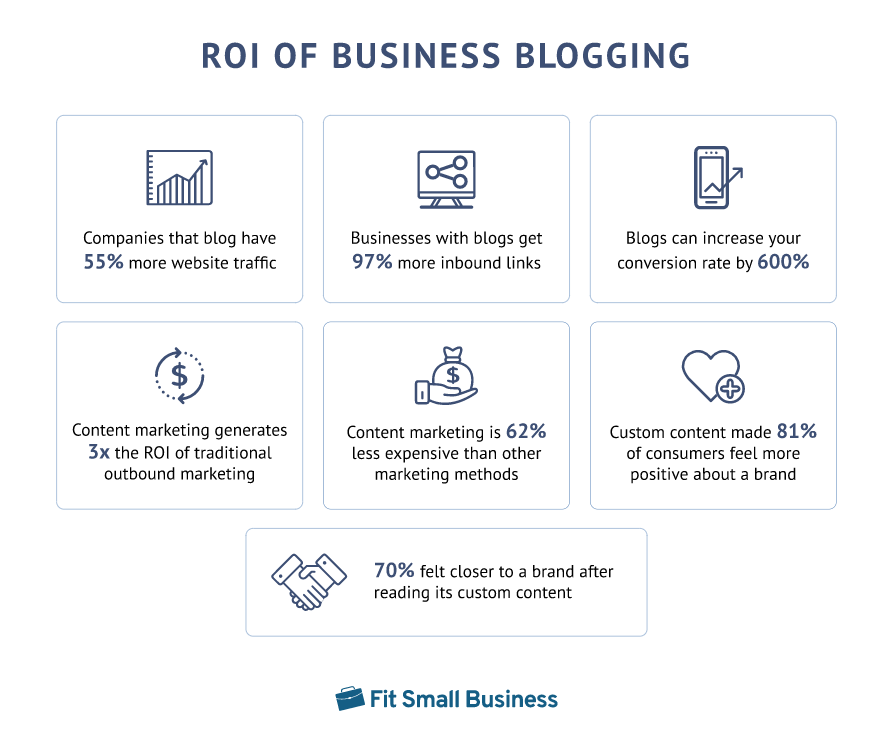
Source: Fit Small Business
Through blogging, businesses can showcase their products or services in an interesting way that piques the interest of readers, encouraging them to explore further and eventually make a purchase.
With regular updates on exciting developments within your ecommerce business, visitors will be encouraged to return time and time again leading to more conversions.
What to blog about: Ideas for ecommerce stores
When it comes to blogging for your ecommerce website, the sky's the limit. You can blog about anything related to your business, products, or industry. However, it's important to make sure that your blog posts are interesting and informative, and that they offer value to your readers.
Whether you're starting out or simply need some inspiration, these helpful tips will get your creative juices flowing. To ensure success in your blog-writing journey, focus on generating relevant topics that are interesting and engaging.
Think of topics that highlight current trends in the ecommerce space, showcase new products and services, or review popular items available in your store. Identifying what type of content you want to produce is essential as it gives clarity to the direction of each post.
Product reviews and comparisons
With product reviews and comparison blogs, customers can easily research and compare different products side by side. They can read about features, benefits, and experiences from other customers who have already purchased the product.
This allows shoppers to gain insight on quality, price point, customer service experience, or other factors that might sway their decision in making a purchase.
Product reviews and comparison blogs also lend credibility to your ecommerce business as they create an air of trustworthiness around your brand.
Example: Trust Pilot
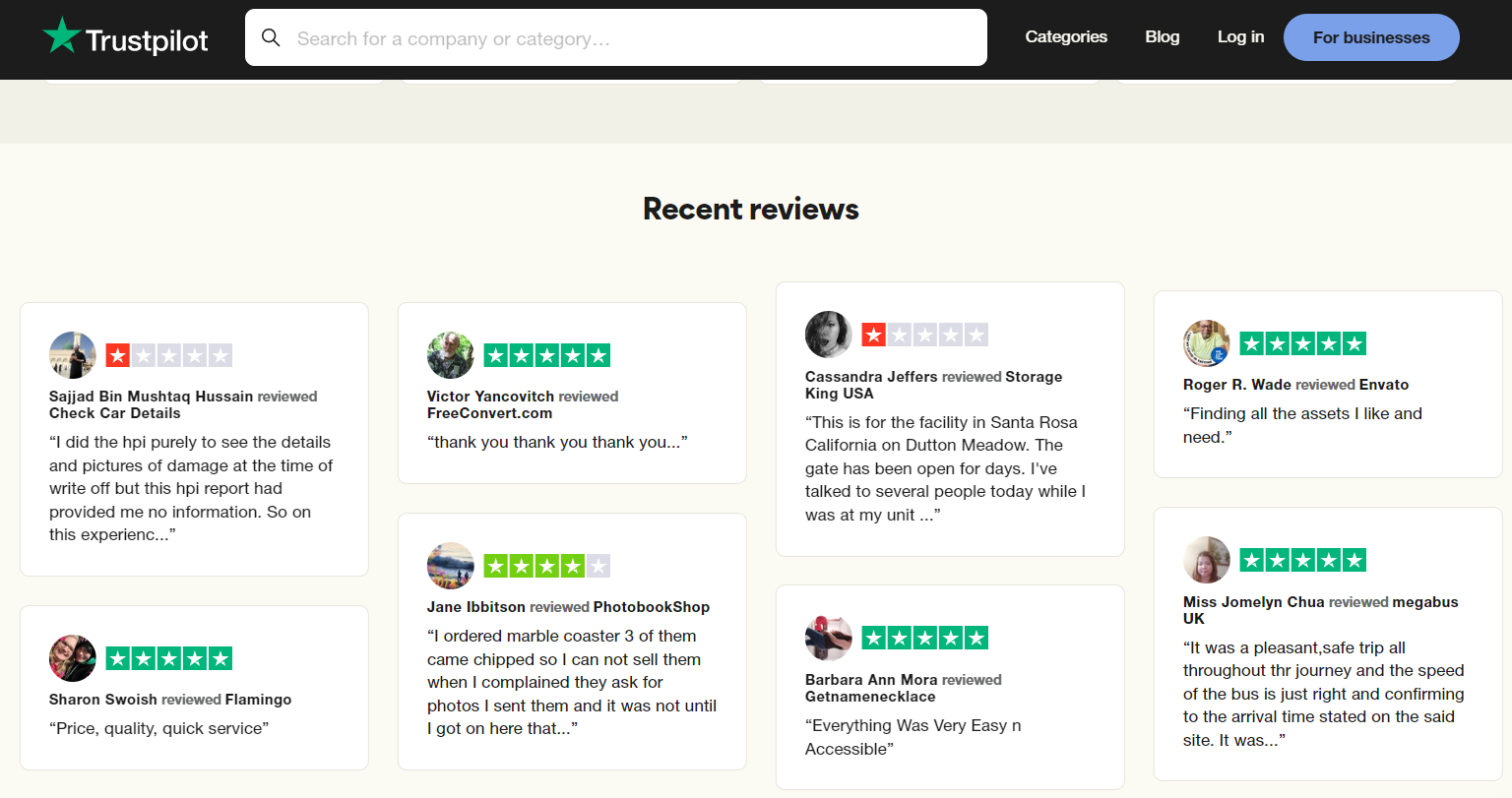
How-to guides and tutorials
Whether you're a beginner or experienced entrepreneur, having a reliable source of information is essential for success. How-to guides and tutorial blogs can be a great way to get the guidance you need to stay ahead in today's competitive ecommerce landscape.
With several resources available online, it can be overwhelming when you're trying to find the right one for your needs. However, by focusing on how-to guides and tutorial blogs that cater specifically towards your ecommerce businesses, you can easily discover the strategies and tips that are tailored to your needs.
Tutorials typically walk through step-by-step instructions with visuals or videos which makes it easier to implement new ideas into practice quickly.
Example: wikiHow
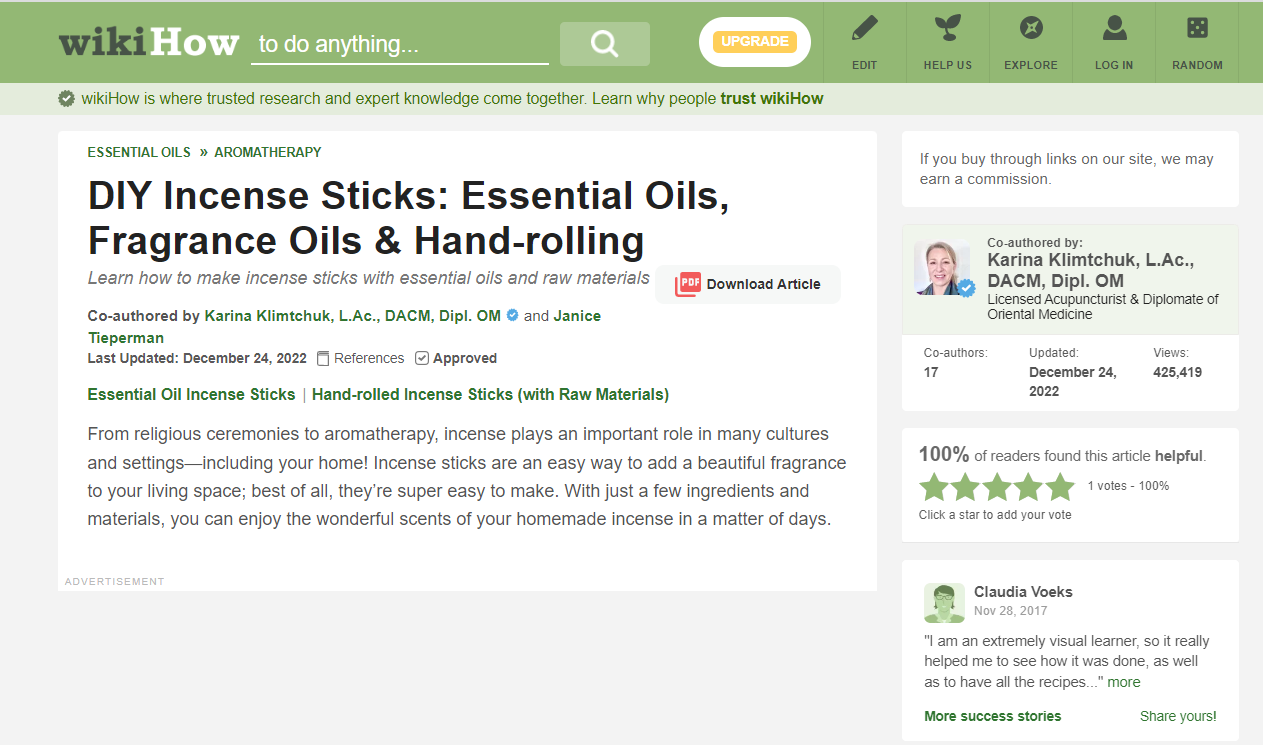
Industry news and trends
As an ecommerce business, staying ahead of the trends is vital! That's why industry news and trend blogs are such an important tool. Knowing what’s going on in the world of ecommerce can give you insights into how to make your website stand out from the competition. Staying informed with industry news and trend blogs can help you determine which strategies will be most effective for increasing sales and boosting customer satisfaction.
There’s no shortage of great industry news and trend blogs available online—all dedicated to giving ecommerce businesses like yours a competitive edge. From expert advice on marketing tactics to data-driven product recommendations, these resources provide up-to-date information that could be invaluable for your business. From helpful guides on latest technology advancements to suggestions on improving customer experience, there’s something for everyone in these amazing resources.
Example: Hubspot

Tips and hacks blogs
Tips and advice blogs provide useful information about the current trends in ecommerce. They provide insights into what’s selling well, who the competition is, and how best to target customers. This helps you stay ahead of the curve when it comes to product selection and marketing strategies giving you a competitive edge in your industry.
This type of blog offers invaluable guidance on topics such as how to find discounts and coupons, which websites offer the best deals, or even when is the best time of year to buy certain items.
It will help you stay up-to-date with industry news so you know about any changes in policies or regulations that may affect your shopping experience. Finally, some blogs may even host contests or giveaways, giving readers yet another reason to tune in.
Example: Dumb Little Man
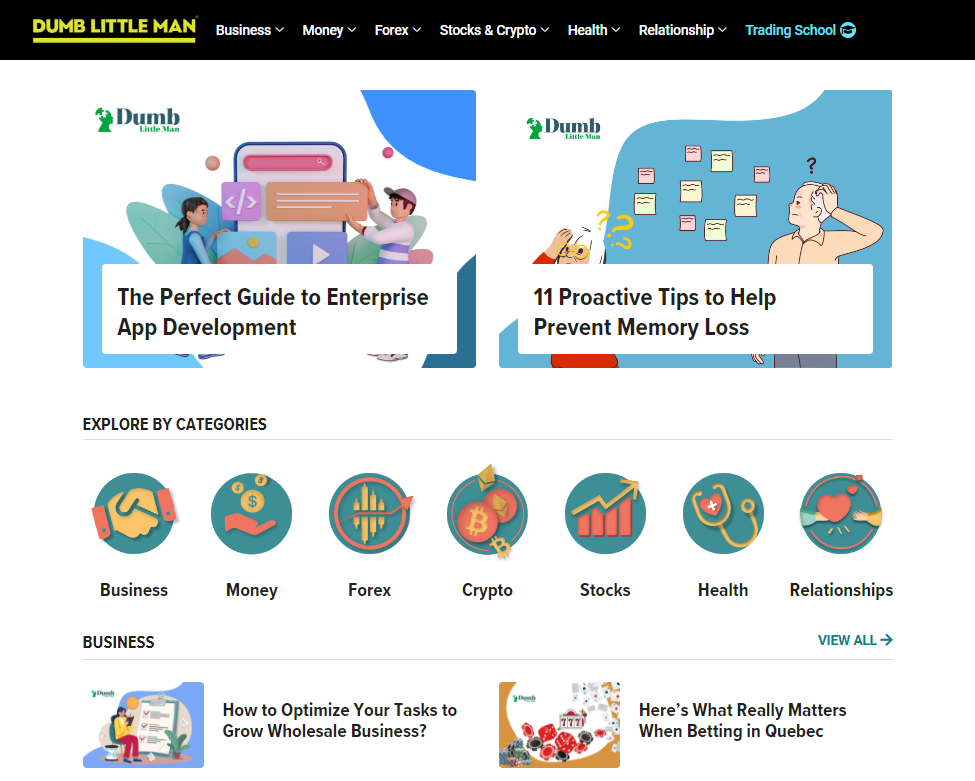
Behind-the-scenes looks at your business
Everyone loves to get a sneak peek into something they find interesting online. Creating behind-the-scenes blogs can help boost customer engagement, as they offer insight into the inner workings of your ecommerce store. From behind-the scenes videos showing how products are made, to interviews with staff members or interesting facts about your company history, these types of posts are sure to capture the attention of current and potential clients.
You can talk about the people behind your ecommerce business, such as employees and key players who help make things happen. Give readers an inside look at how things work from day to day and let them in on any exciting updates or changes you might have planned for the future.
Showcase photos of employees or any fun activities that take place in the office, like happy hours or team lunches. When done right, this can help convert prospective buyers into loyal followers in no time by creating an emotional connection between readers and your business.
Example: The Charming Olive
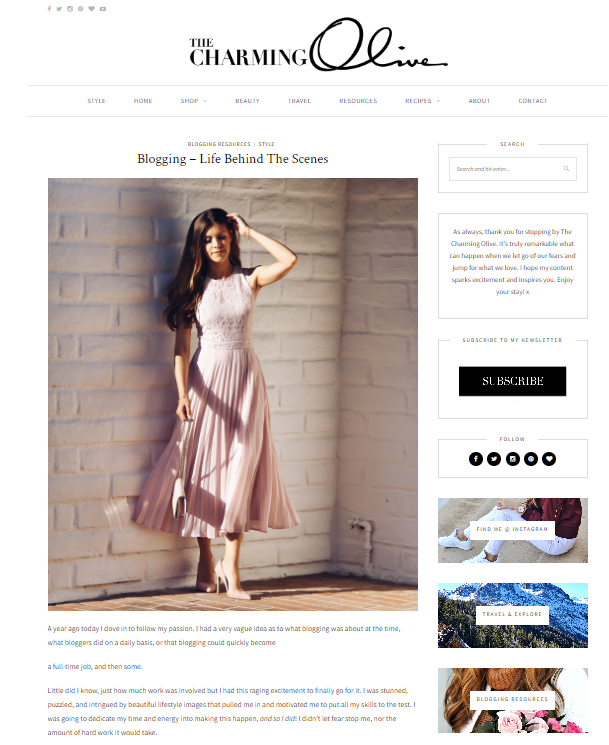
Tips for getting started with blogging for your ecommerce site
If you're new to blogging, don't worry—it's easy to get started. Here are a few tips:
Set goals for your ecommerce blog
Creating specific goals is an essential part of any successful blogging strategy. Whether you want to increase traffic, engagement, or conversions, setting SMART goals can help you track progress and stay motivated. SMART goals should be specific, measurable, attainable, relevant, and time bound so they're easier to accomplish.
Consider setting daily, weekly, or monthly targets so it's easier to stay on top of your progress. Creating rewards for yourself when you reach each goal will make it more enjoyable.
Research your topics
Start by understanding what topics your customers are interested in.
What do they need help with?
What are their struggles when it comes to ecommerce businesses?
What do they want to know more about?
Are there any pain points you can address?
Utilizing social media analytics tools, online surveys, and focus groups can be helpful in gathering this data so you know exactly what type of content will best serve your readers.
You can also look at popular industry blogs for inspiration. Take note of which topics attract the most attention through things like shares or comments from readers. They will provide valuable insights into top trends and topics related to ecommerce businesses.
Establish a consistent writing schedule
Creating a regular writing schedule can help your business stay organized and give structure to your creative ideas. This will help keep track of tasks such as research, planning, creating drafts, editing, publishing, and promoting each article.

Start by outlining what kind of content you want to create and when it should be published. This will help keep things on track as your business grows. Once you've established this plan, focus on creating high-quality content that resonates with readers while staying true to your brand's mission and vision.
Set deadlines that work for you and stick with them so each piece of content is given the attention it deserves before being published.
Promote your blog posts
The key is to use a variety of digital platforms, both free and paid, to spread the word. Social media sites like Twitter and Facebook are great for boosting reach, plus you can also take advantage of advertising opportunities on Google AdWords or other networks. You can even partner with influencers or pay for sponsored content if that fits within your budget. Semrush Blog states that marketing efforts for bloggers include social media (94%), SEO (63%), email marketing (66%), partnerships and collaborations (19%), community or forum management (13%), influencer collaboration (12%), and paid services (15%).
Don’t forget about email lists either. Send out regular newsletters with links back to your blog posts so subscribers know when you have new content available. Plus, there are plenty of SEO tricks you can use to help boost rankings in search engine results pages (SERPs).
Build an engaged audience
Creating great content that resonates with your target audience is essential for driving traffic and engagement with your blog.
First, make sure each post offers value. You want readers to keep coming back, so focus on providing interesting content that’s relevant and helpful to them. Ask yourself what problem your readers are trying to solve, and then write posts that will help them find a solution.
Use visuals like photos or videos whenever possible; this will make it easier for people to follow along with the content. Another key element of successful blogging is engaging with readers through comments and social media platforms like Twitter and Instagram.

Finally, it’s important to remain consistent to sustain a steady flow of incoming visitors and followers. Regularly scheduling posts allows you to build relationships over time while also showcasing products or services offered by your ecommerce business.
One way of engaging people on a regular basis is with live interactions such as going live on Instagram and Facebook or organizing webinars.
Track and measure results
Tracking your blog's performance is essential for understanding what content resonates most with your target audience and how to best use the insights to improve customer engagement. Looking at factors such as page views, click-through rates (CTR), and time spent on page will give you an indication of how successful each article is performing.
If you're an ecommerce business owner looking to get the most out of your blog, tracking and measuring the results are key. Knowing how well your posts are performing is essential when it comes to achieving a successful blog. Not only will this help measure success, but it can also help identify areas where improvements can be made.

There are a variety of methods and tools that can be used when tracking and measuring blog performance. From basic analytics such as page views and bounce rates to more complex insights including customer engagement, there’s plenty of data that can be collected.
How often should you blog
Regularly blogging can help your business keep up with the ever-changing online landscape, build customer relationships, and establish your brand as an authority in the industry. But how often should you blog for your ecommerce business?
The answer depends on many factors like the size of your company, resources, existing content strategy, and more. Even if you don’t have a lot of time or resources available to dedicate to creating new posts regularly, there are still ways that you can create engaging content every month that will benefit your ecommerce business.

It’s important to find the perfect balance; posting too much can be overwhelming for readers and search engines alike, but not posting enough may cause people to forget about your business.
Ideally, you should aim for two to three blog posts per week on topics related to your services or products. This allows readers to stay up-to-date on new trends in the industry while also giving them interesting content they can share with their friends.
A good starting point would be to aim for one blog post per week. This will give you enough time to research topics properly and craft quality posts while also ensuring that customers will be coming back regularly for new content.
Conclusion
Starting a blog for more ecommerce traffic can be an invaluable investment of time and energy. Whether you're looking to increase brand awareness, create meaningful connections with customers, or drive more leads, there are ample benefits to starting your own blog.
With all the benefits that come along with blogging, there's no reason you shouldn't start today! With all the benefits that come along with blogging, there's no reason you shouldn't start today! Zoho Commerce makes it easy to create and manage blogs for your ecommerce business with powerful built-in features. Start writing engaging blog content for your store today and experience the difference it makes for your business.

